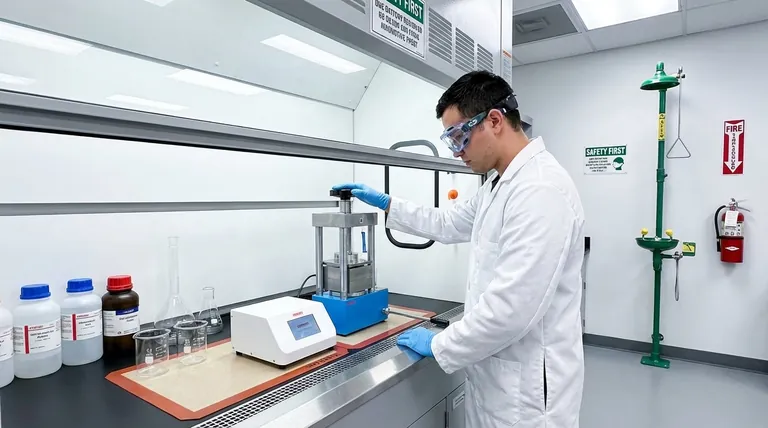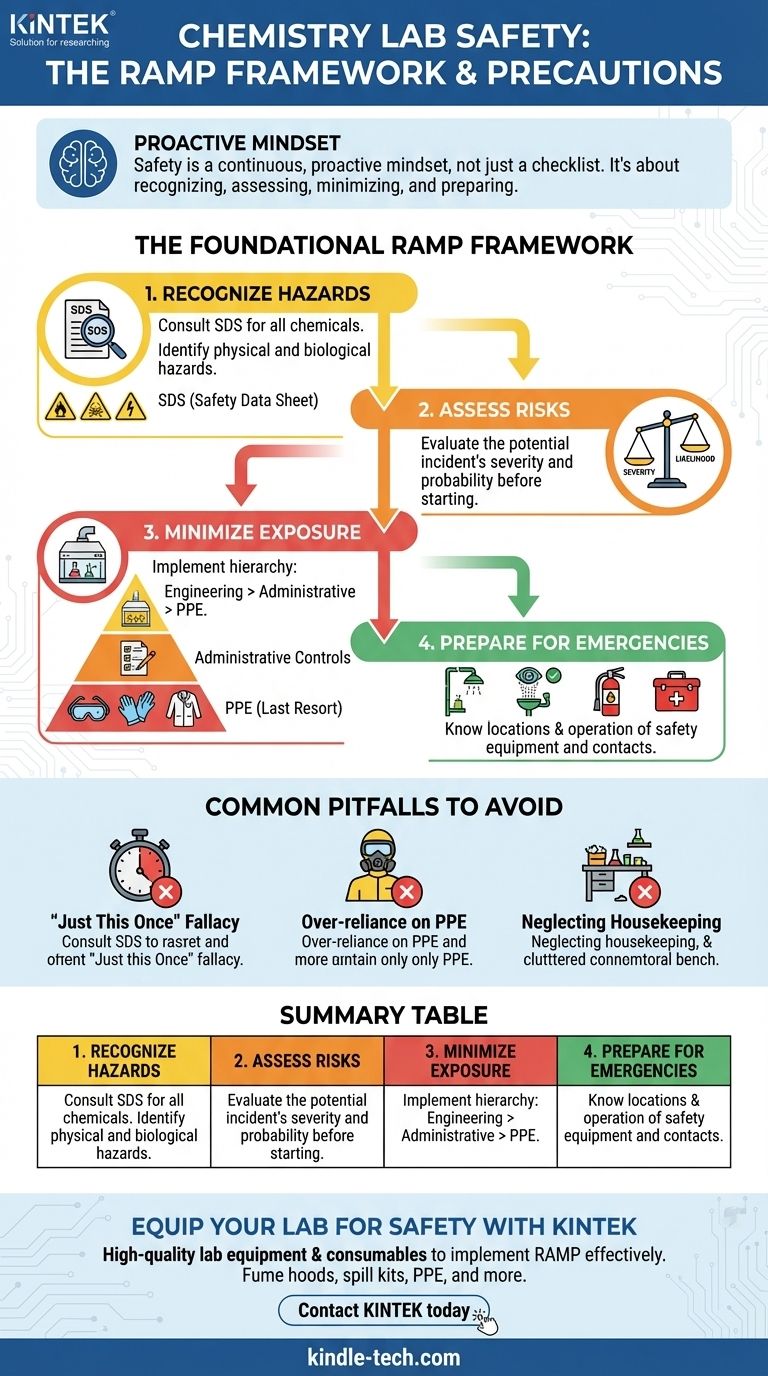Die wichtigsten Vorsichtsmaßnahmen in einem Chemielabor drehen sich um einen grundlegenden Respekt vor den beteiligten Materialien und Prozessen. Mindestens umfasst dies das ständige Tragen der geeigneten persönlichen Schutzausrüstung (PSA), das Verständnis der spezifischen Gefahren jeder verwendeten Chemikalie vor dem Umgang damit und die Kenntnis des genauen Standorts und der Funktionsweise aller Notfallsicherheitsausrüstungen. Arbeiten Sie niemals allein und sorgen Sie immer für einen sauberen und organisierten Arbeitsplatz, um Unfälle zu vermeiden.
Wahre Laborsicherheit ist keine auswendig zu lernende Checkliste von Regeln, sondern eine kontinuierliche, proaktive Denkweise. Sie basiert auf einem Rahmenwerk zur Erkennung von Gefahren, zur Risikobewertung, zur Minimierung der Exposition und zur Vorbereitung auf Notfälle, noch bevor ein Experiment beginnt.

Das grundlegende Framework: RAMP
Eine robuste Sicherheitskultur basiert auf dem RAMP-Prinzip, einem einfachen, aber wirkungsvollen Rahmenwerk für die Herangehensweise an jede Aufgabe im Labor.
Gefahren erkennen (Recognize the Hazards)
Bevor jegliche Arbeit beginnt, müssen Sie die potenziellen Schadensquellen identifizieren. Gefahren sind nicht immer offensichtlich.
Jede Chemikalie ist mit einem Sicherheitsdatenblatt (SDB) verbunden, früher bekannt als MSDS. Dieses Dokument ist Ihre primäre Informationsquelle bezüglich Entflammbarkeit, Toxizität, Reaktivität und erforderlicher Sicherheitsmaßnahmen.
Über Chemikalien hinaus sollten physikalische Gefahren wie Hochdrucksysteme, extreme Temperaturen und elektrische Geräte berücksichtigt werden. Biologische Gefahren erfordern, falls zutreffend, ebenfalls ihre eigenen spezifischen Protokolle.
Risiken bewerten (Assess the Risks)
Die Erkennung einer Gefahr ist der erste Schritt; als Nächstes folgt die Bewertung des damit verbundenen Risikos. Das Risiko ist die Kombination aus der Schwere eines potenziellen Vorfalls und der Wahrscheinlichkeit seines Eintretens.
Fragen Sie sich: Was ist das Worst-Case-Szenario? Wie könnte dieses Experiment fehlschlagen? Eine geringe Menge eines milden Reizstoffs stellt ein ganz anderes Risiko dar als ein großes Volumen einer stark korrosiven oder explosiven Substanz.
Diese Bewertung bestimmt das Ausmaß der Kontrollmaßnahmen, die Sie für das Verfahren ergreifen müssen.
Gefahren minimieren (Minimize the Hazards)
Dies ist der aktive Teil der Sicherheit – die Implementierung von Kontrollen zur Risikominderung. Dies geschieht in einer klaren Hierarchie.
Die effektivste Methode sind technische Kontrollen (Engineering Controls), d. h. physische Installationen, die die Gefahr beseitigen. Das wichtigste Beispiel hierfür ist der Laborabzug, der giftige oder flüchtige Dämpfe vom Benutzer wegführt.
Als Nächstes folgen organisatorische Kontrollen (Administrative Controls), also die Verfahren und Protokolle, denen Sie folgen. Dazu gehören die ordnungsgemäße Kennzeichnung aller Behälter, das niemals alleinige Arbeiten und die Erstellung einer Standardarbeitsanweisung (SOP) für Ihr Experiment.
Die letzte Verteidigungslinie ist die Persönliche Schutzausrüstung (PSA). Dazu gehören spritzwassergeschützte Schutzbrillen, ein flammhemmender Laborkittel, geeignete chemikalienbeständige Handschuhe und geschlossene Schuhe. PSA verhindert den Vorfall nicht, kann Sie aber vor Verletzungen schützen, falls er doch eintritt.
Für Notfälle vorbereitet sein (Prepare for Emergencies)
Selbst bei bester Planung können Unfälle passieren. Vorbereitung ist nicht verhandelbar.
Sie müssen den genauen Standort und die korrekte Verwendung der Notdusche, der Augenspülstation, des Feuerlöschers und des Chemikalienbindemittels (Spill Kit) kennen. Im Notfall zählen Sekunden, und es bleibt keine Zeit, nach Anweisungen zu suchen.
Stellen Sie sicher, dass Notfallkontaktdaten deutlich ausgehängt sind und dass Sie das spezifische Verfahren des Labors zur Meldung von Vorfällen verstehen, egal wie geringfügig diese erscheinen mögen.
Häufige Fallstricke und Missverständnisse
Die Einhaltung von Sicherheitsprotokollen kann durch Selbstzufriedenheit und ein Missverständnis darüber, wo die wirklichen Gefahren liegen, untergraben werden. Das Vermeiden dieser häufigen Fallen ist genauso wichtig wie die Befolgung der Regeln selbst.
Der Trugschluss des „Nur dieses eine Mal“
Die überwiegende Mehrheit der Laborunfälle wird nicht durch exotische, hochriskante Verfahren verursacht. Sie werden durch eine geringfügige Abweichung von einer Routineaufgabe verursacht – das Weglassen der Schutzbrille für einen „schnellen“ Transfer oder das Versäumnis, den Abzug für eine „kleine“ Menge einer Chemikalie zu benutzen.
Diese Normalisierung von Abweichungen ist die größte Bedrohung für eine sichere Laboratmosphäre. Es gibt keine Aufgabe, die so schnell ist, dass sie das Überspringen grundlegender Sicherheitsmaßnahmen rechtfertigt.
Übermäßiges Vertrauen in PSA
Viele sehen PSA als das primäre Werkzeug für die Sicherheit an. Das ist falsch. PSA ist die letzte Verteidigungslinie und soll Sie schützen, wenn alle anderen Kontrollen versagt haben.
Sich auf Handschuhe zu verlassen, um Sie vor Spritzern zu schützen, ist weitaus weniger effektiv, als ein Verfahren zu implementieren, das das Spritzen von vornherein verhindert. Priorisieren Sie immer technische und organisatorische Kontrollen gegenüber PSA.
Vernachlässigung guter Ordnung und Sauberkeit (Housekeeping)
Eine überfüllte Werkbank, nicht gekennzeichnete Behälter und blockierte Notausgänge schaffen unnötige und völlig vermeidbare Gefahren. Ein sauberes und organisiertes Labor ist ein direktes Spiegelbild einer professionellen und sicherheitsbewussten Denkweise.
Gute Ordnung und Sauberkeit dienen nicht nur der Ästhetik; sie sind eine entscheidende organisatorische Kontrolle, die die Wahrscheinlichkeit von Verschüttungen, Kreuzkontaminationen sowie Stolper- und Sturzunfällen reduziert.
Anwendung auf Ihre Rolle
Ihr Ansatz zur Sicherheit hängt von Ihren Verantwortlichkeiten in der Laborumgebung ab.
- Wenn Sie Laborleiter oder Hauptforscher sind: Ihr Hauptaugenmerk liegt auf der Etablierung robuster technischer Kontrollen und der Förderung einer Kultur, in der Sicherheitsprotokolle konsequent und universell befolgt werden.
- Wenn Sie Forscher oder Student sind: Ihr Hauptaugenmerk liegt auf der Eigenverantwortung – dem gründlichen Verständnis der RAMP-Prinzipien für jede von Ihnen durchgeführte Aufgabe und dem Verzicht auf die Durchführung, wenn Sie sich unvorbereitet oder unsicher fühlen.
- Wenn Sie ein neues Labor entwerfen oder einrichten: Ihr Hauptaugenmerk muss darauf liegen, Sicherheit von Anfang an in die physische Umgebung zu integrieren, mit korrekter Belüftung, logischem Arbeitsablauf und leicht zugänglicher Notfallausrüstung.
Letztendlich sind exzellente Wissenschaft und exzellente Sicherheit untrennbar miteinander verbunden.
Zusammenfassungstabelle:
| Kategorie der Vorsichtsmaßnahme | Wesentliche Maßnahmen |
|---|---|
| Gefahren erkennen | Sicherheitsdatenblätter (SDB) für alle Chemikalien konsultieren. Physikalische und biologische Gefahren identifizieren. |
| Risiken bewerten | Schweregrad und Wahrscheinlichkeit potenzieller Vorfälle vor Arbeitsbeginn einschätzen. |
| Gefahren minimieren | Technische Kontrollen (z. B. Laborabzüge), organisatorische Kontrollen nutzen und geeignete PSA tragen. |
| Für Notfälle vorbereitet sein | Standort und Funktion von Notduschen, Augenspülstationen, Feuerlöschern und Chemikalienbindemitteln kennen. |
| Häufige Fallstricke vermeiden | Sicherheitsmaßnahmen niemals für „schnelle“ Aufgaben überspringen. Kontrollen über die bloße PSA priorisieren. Arbeitsplatz sauber halten. |
Rüsten Sie Ihr Labor für Sicherheit und Erfolg mit KINTEK aus
Die Schaffung einer sicheren Laborumgebung ist die Grundlage für zuverlässige Forschung und Entdeckungen. Bei KINTEK verstehen wir, dass Ihre Arbeit von einem sicheren und gut ausgestatteten Raum abhängt. Wir sind spezialisiert auf die Bereitstellung hochwertiger Laborgeräte und Verbrauchsmaterialien, die Sie benötigen, um das RAMP-Framework effektiv umzusetzen.
Ob Sie Laborleiter sind, der eine neue Einrichtung einrichtet, oder Forscher, der zuverlässige Sicherheitsausrüstung benötigt – KINTEK ist Ihr vertrauenswürdiger Partner. Von Laborabzügen und Chemikalienbindemitteln bis hin zu persönlicher Schutzausrüstung (PSA) liefern wir die Werkzeuge, die Ihnen helfen, Gefahren zu minimieren und Ihr Team zu schützen.
Bereit, eine stärkere Sicherheitskultur in Ihrem Labor aufzubauen? Lassen Sie sich von unseren Experten bei der Auswahl der richtigen Ausrüstung für Ihre spezifischen Bedürfnisse unterstützen.
Kontaktieren Sie KINTEK noch heute, um Ihre Anforderungen an die Laborsicherheit zu besprechen!
Visuelle Anleitung

Ähnliche Produkte
- 24T 30T 60T Beheizbare Hydraulische Pressmaschine mit Heizplatten für Labor-Heißpressen
- Verdampfungsschale für organische Substanz
- Anpassbare Hochdruckreaktoren für fortschrittliche wissenschaftliche und industrielle Anwendungen
Andere fragen auch
- Was ist der Zweck einer Heißpresse? Materialien durch Hitze und Druck umwandeln
- Was sind die Vorteile des Pressens und Sinterns? Herstellung komplexer, hochfester Teile zu kostengünstigen Konditionen
- Was ist eine heiße hydraulische Presse? Wärme und Druck für die fortschrittliche Fertigung nutzen
- Warum müssen Sie die Sicherheitsverfahren bei der Verwendung von Hydraulikwerkzeugen befolgen? Katastrophale Ausfälle und Verletzungen vermeiden
- Besitzt eine hydraulische Presse Wärme? Wie beheizte Platten fortschrittliches Formen und Aushärten ermöglichen


